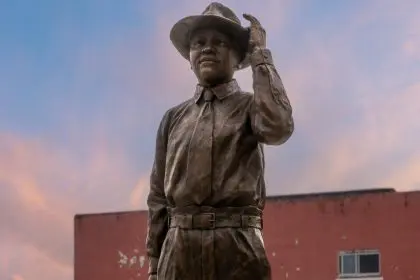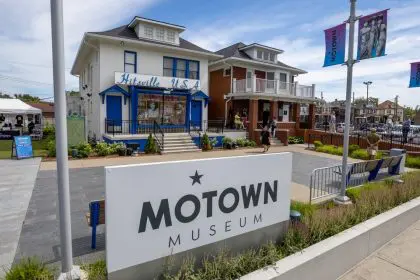The grand dame of American performing arts institutions—those imposing marble edifices with their crystal chandeliers and gilt-edged programs—have long mastered the art of keeping people out while appearing to welcome everyone in. The unsaid rules that govern these spaces—when to clap, what to wear, which references to catch—create invisible but formidable barriers that have successfully kept these cultural sanctuaries the domain of the privileged few for generations. Enter Nataki Garrett, a director whose work has become nothing short of revolutionary in the way it dismantles these artificial barriers with the elegant precision of a master safecracker.
The subtle tyranny of cultural gatekeeping
“I think we’ve been taught in this society that certain art forms are for some sort of highbrow, upper echelon folks who have a certain kind of experience and resource,” Garrett explains, settling into a conversation about her latest directorial challenge at Detroit Opera. Her eyes flash with a mixture of amusement and defiance that has become her signature. “But actually the art doesn’t care about that. It actually knows you and knows your spirit and knows your access to empathy and is trying to get in there with you.”
This insight, delivered with the casual confidence of someone who has spent decades thinking about who belongs where in American culture, cuts to the heart of the problem. The issue has never been that Shakespeare or Beethoven or Puccini are inherently inaccessible to diverse audiences. Rather, it’s that generations of cultural arbiters have constructed elaborate fortresses around these art forms, complete with moats of specialized knowledge and drawbridges that only lower for those who already know the passwords.
Garrett, whose resume reads like an aspirational vision board for American theater directors—Oregon Shakespeare Festival, Yale Repertory Theatre, Actors Theatre of Louisville—has built her career not by playing within these systems but by systematically dismantling them from positions of considerable influence. Her current project, helming “The Central Park Five” at Detroit Opera, represents perhaps the most perfect convergence yet of her artistic sensibilities and political consciousness.
The alchemy of emotional connection
Watch Garrett in rehearsal and you’ll witness a fascinating inversion of traditional directorial approach. Where many directors construct elaborate intellectual scaffolding around performances, Garrett’s method is more alchemical—creating conditions where emotional truth can materialize without interference.
“There’s something about our senses that we understand what art is saying. Our bodies, our spirits, our minds, our hearts understand what it’s trying to say to us, even if our intellect doesn’t catch up with it,” she observes, her hands tracing invisible patterns in the air as if summoning these connections into being. This sensory-first approach manifests in productions that hit viewers in the solar plexus before reaching their cerebral cortex—a sequence that makes her work accessible across vastly different audience demographics without sacrificing sophistication.
In an American cultural moment where intellectual posturing often substitutes for genuine artistic response, Garrett’s insistence on emotional authenticity feels quietly radical. Her productions create permission for audiences to react honestly rather than performatively, removing the pressure to have the “correct” response that keeps many potential viewers away from high art entirely.
The architecture of artistic experience
The rehearsal room under Garrett’s guidance becomes a masterclass in how to create what she calls “containers” for artistic expression—frameworks that support performers without constraining them. “My work with this design team was, how much can we make sure that the machine of the room holds the story so that they can stand under that light and deliver the performance and the pristine quality of their artistry can come through,” she explains.
This containment theory of direction—creating sturdy vessels that can hold explosive artistic content without shattering—proves particularly effective for work dealing with traumatic historical material like “The Central Park Five.” The production must simultaneously honor the brutal realities of racial injustice while creating sufficient aesthetic distance for audiences to process rather than simply retraumatize.
What distinguishes Garrett’s containment approach from more conventional direction is her willingness to step back once the container is constructed. “It’s not so much how much I can do. It’s more about how much I can get out of their way,” she notes with characteristic lack of ego. “What can I do to hold them there, and then give them what they need to be held and supported, and get my hand out of the way.”
This philosophy represents a striking departure from the director-as-auteur approach that has dominated American theater for decades, where productions often become vehicles for directorial vision rather than text or performance. Garrett’s approach suggests something more collaborative and ultimately more sustainable—creating systems that enhance rather than exploit the artists working within them.
The radical politics of claiming space
Perhaps the most revolutionary aspect of Garrett’s directorial approach lies not in what happens on stage but in how she conceptualizes who belongs in the audience. Raised in a family that refused to accept the cultural apartheid of American arts institutions, she carries that inheritance into her work with evangelical fervor.
“I was raised by a family that said that all of this is for us,” Garrett recalls, a certain steeliness entering her typically warm demeanor. “My mother made sure I went to the opera, my grandmother made sure I went to the symphony. I went to see the ballet, and so it’s for us, because it exists and we perform in it. It’s for us because our taxpayer dollars pay for it. It’s for us, because we are a part of the fabric of this society.”
This perspective demolishes the grateful-to-be-included framework that has dominated diversity initiatives in American arts institutions. Instead of positioning Black audiences as beneficiaries of institutional generosity when invited into traditionally white spaces, Garrett asserts their rightful ownership of all cultural forms and institutions. “We should not feel like we should exclude ourselves from it,” she insists with the certainty of someone who has thought deeply about belonging. “It’s important for us to not only go to see these stories, but to see all the stories, because they all belong to us.”
In Detroit, where “The Central Park Five” resonates with particular poignancy given the city’s own complex history of racial justice struggles, Garrett’s approach to audience development reflects this ownership philosophy. Rather than generic marketing, she extends specific invitations that acknowledge the significance of Black Detroit’s presence: “I want all the Greeks to come out. I want every church. The royal night. I want all of us to come… Everybody from Motown should be here.”
The currency of relevance in artistic exchange
Modern directors face the constant challenge of demonstrating why historical material or traditional forms matter to contemporary audiences. For Garrett, this relevance emerges naturally from her personal connection to the material combined with her acute awareness of current political currents.
“The actual story of the five is impressed upon me and it’s a part of my experience,” she says of the Central Park Five case. “I remember this story, and I remember the impact of this story.” This personal connection creates authentic bridges between historical events and their contemporary significance—particularly given the involvement of certain political figures who continue to shape American public life.
The timing of this production during an election year featuring Donald Trump—who famously took out full-page newspaper advertisements calling for the death penalty for the teenagers before their trial—creates unavoidable contemporary resonance. “Right now, the President of the United States continues to persecute people in this same way,” Garrett notes, drawing connections to contemporary policies. “By taking out an ad in the New York Post, and by continuing to purport this idea that these boys, who are now men are guilty of a crime that they did not commit, he continues to exacerbate this idea that any one of us at any moment could have this experience.”
This threading of historical narrative with current political reality transforms what might otherwise be a period piece into urgent contemporary commentary—without sacrificing artistic integrity or reducing complex material to simplistic political messaging.
The ethics of ladder-building in artistic leadership
In an industry where ego often functions as both engine and obstacle, Garrett’s leadership philosophy stands apart for its focus on creating pathways rather than pedestals. “My superpowers is that I know how to make a path. I know how to crawl up a path, climb a path, clear a path. I know that it’s about creating a path,” she explains with characteristic metaphorical precision. “You lead from the center. You pull those forward who are behind you and the job is to create a path for somebody to come up through.”
This ladder-building approach to artistic leadership has particular significance in fields where systemic barriers have historically limited access for artists from underrepresented backgrounds. Rather than positioning herself as an exceptional individual who transcended these barriers through extraordinary talent, Garrett emphasizes the structural work of creating sustainable routes for those who follow.
Her advice to emerging artists reflects this structural focus. “Don’t let anybody tell you that your story isn’t important. If it’s important to you, it’s important to all of us,” she counsels. “Don’t ask for permission. You make the space. You can either move into the spaces that you believe have the resources or create the space, and the resource will come.”
This perspective shifts focus from individual achievement to collective transformation—a particularly significant reframing in artistic disciplines that have traditionally emphasized exceptional individual genius over community impact.
The delicate ecology of representation and reciprocity
The relationship between diverse artists, institutions, and audiences represents a delicate ecology that requires careful tending from all participants. Garrett observes this interconnection with particular clarity: performers “are working very hard as artists, in these spaces that sometimes they only get to come in and tell these stories, if they know that you’re coming, and they know that you’re coming back.”
This insight illuminates the crucial distinction between tokenistic representation and sustainable transformation in performing arts. When institutions program diverse work without building authentic relationships with diverse audiences, they create unsustainable pressure on artists who find themselves performing for audiences unprepared to receive their work. Similarly, when diverse audiences attend productions that fail to deliver authentic representation, their skepticism about institutional commitment deepens.
For Garrett, the solution lies in authentic invitation and reciprocal commitment. “When I direct, in my own heart and mind, I direct for us. I want us to come see it. I want us to be in the room. I want us to know that the story is for us,” she explains. “So often, we go to see anything performed, and we’re witnessing somebody else’s experience. This is an opportunity for the status quo to be flipped for the story to be about our experience, our exoneration, our joy, our ability to move on with our lives. Our redemption.”
This reciprocity—institutions authentically inviting diverse audiences, audiences showing up to support diverse programming, artists creating work that speaks authentic truth—creates the possibility for sustainable transformation rather than temporary diversity initiatives that fade with changing institutional priorities or funding cycles.
As American performing arts institutions continue navigating their own long-overdue reckonings with histories of exclusion, Garrett’s approach offers a blueprint for authentic transformation. By focusing on emotional truth, creating sturdy containers for artistic expression, asserting universal ownership of cultural resources, establishing contemporary relevance, building leadership ladders, and nurturing reciprocal relationships, she demonstrates how directorial vision can bridge seemingly unbridgeable cultural divides. The result isn’t just more diverse programming, but a fundamental reimagining of who performing arts are for and why they matter in contemporary American life.

















